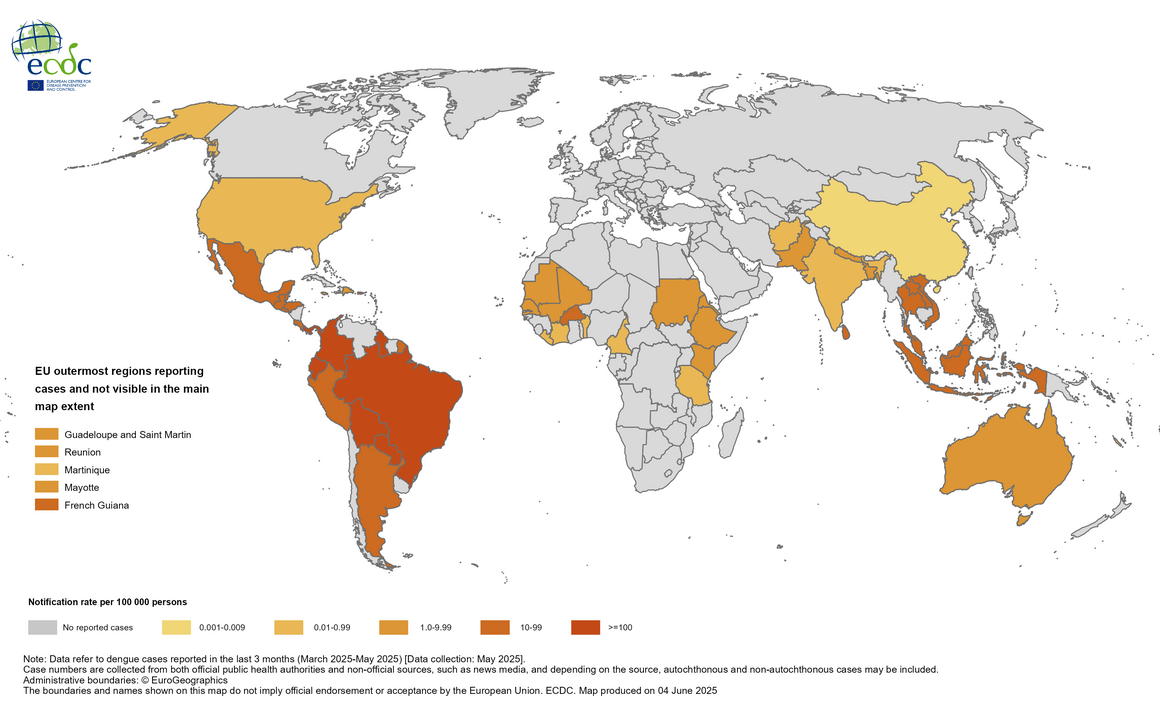Dengue worldwide overview
Situation update, June 2025
Since the beginning of 2025, over three million dengue cases and over 1 400 dengue-related deaths have been reported from 90 countries/territories in the WHO Regions of the Americas (PAHO), South-East Asia and West Pacific Regions (SEARO and WPRO, respectively), in the Eastern Mediterranean WHO Region (EMRO) and in Africa.
In mainland Europe, no autochthonous cases have been reported in 2025. However, cases have been reported from the EU's outermost regions.
Three-month dengue virus disease case notification rate per 100 000 population, March 2025-May 2025

Detailed overview
In Madeira, two locally acquired cases were reported on 18 February, with symptoms onset in January 2025. In the third week of January, entomological investigations confirmed the presence of dengue in mosquitoes captured on Madeira.
In Guadeloupe, the current situation is classified as epidemic of phase 4 level 1 (confirmed epidemic) (Epidemiological Bulletin of French Antilles, 23 May 2025). The decreasing trend observed since earlier in the year continues. The most prevalent serotype continues to be DENV-3 (Epidemiological Bulletin of French Antilles, 23 May 2025). In Martinique, the epidemiological situation is characterised as phase 1 (sporadic cases reported; Epidemiological Bulletin of French Antilles, 23 May 2025). The classification was modified in April following a decrease in reported cases since March (Epidemiological Bulletin of French Antilles, 3 April 2025)). In Saint Martin and Saint Barthelemy dengue circulation continues, but at lower levels (epidemic phase 1), with only sporadic cases or outbreaks without epidemiological links among them reported (Epidemiological Bulletin of French Antilles, 23 May 2025).
In French Guiana, case numbers have decreased in the past months and show a stable trend at lower levels with an average of 10 cases per week (Health surveillance in French Guiana. Bulletin of 15 May 2025) . The most prevalent circulating serotype is DENV-2. The trends are monitored (Health surveillance in French Guiana. Bulletin of 15 May 2025)).
In Mayotte, 21 dengue cases have been reported this year (Chikungunya and dengue in Mayotte. Bulletin 30 May 2025.) In Reunion, 44 dengue cases, of which 17 confirmed, have been reported since the beginning of the year and as of 25 May 2025 (Health surveillance in Réunion. Bulletin of 30 May 2025.).
A summary of recent epidemiological trends of dengue outside EU/EEA of the first months of 2025 is presented below. The summary is based on available information from official sources and reports from different countries/territories.
In the PAHO, as of week 19 of 2025, over 2.7 million cases have been reported of which 40% are laboratory confirmed. The currently reported cases are 71% less compared to the cases reported in the same period in 2024 and 13% above the average of the last 5 years, according to the WHO PAHO report published on 29 May 2025. While all serotypes have been reported as of week 19 of 2025, their distribution differs in the different countries of PAHO (Report on the epidemiological situation of dengue in the Americas).
In Bangladesh, according to the country report published on 25 May 2025, the total number of dengue cases in 2025 is higher compared to the same period in 2024, while the number of death in 2025 is lower (3 972 cases and 23 deaths as 25 May 2025 vs 2 853 cases and 41 deaths in May 2024).
According to the SEARO report published on 27 May 2025, Thailand reported total of 2 271 dengue cases in April 2025 and a total of 10 992 cases since the beginning of the year. Compared to previous years, although continuous, dengue circulation is at lower levels in Thailand.
In Laos, Malaysia, Vietnam and Singapore in 2025 so far dengue cases are lower than those reported in 2024 (Laos: 1 040 cases as 25 April 2025; Malaysia: 21 679 cases as of 3 May 2025; Vietnam: 20 832 cases as of 18 May 2025; Singapore: 1 895 cases as of 17 May 2025 WPRO Dengue Situation update of 29 May 2025).
In Afghanistan (EMRO), in 2025, the number of suspected dengue fever cases shows an increase compared in the last weeks, with 345 cases reported as of 17 May 2025.
In 2025, in Africa, over 7 000 cases and six deaths had been reported from Burkina Faso, Cabo Verde, Comoros, Guinea, Mali, Senegal and Sudan (Africa CDC Epidemic Intelligence Report of 1 June 2025).
Map
Twelve-month dengue virus disease case notification rate per 100 000 population, June 2024 - May 2025
Since the beginning of 2025, over three million dengue cases and over 1 400 dengue-related deaths have been reported from 90 countries/territories in the WHO Regions of the Americas (PAHO), South-East Asia and West Pacific Regions (SEARO and WPRO, respectively), in the Eastern Mediterranean WHO Region (EMRO) and in Africa.
ECDC assessment
Dengue risk assessment for mainland EU/EEA
Dengue is an Aedes-borne disease widely distributed in tropical and subtropical regions.




